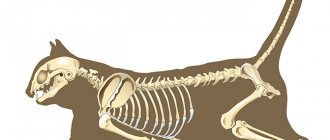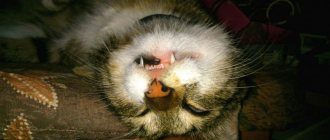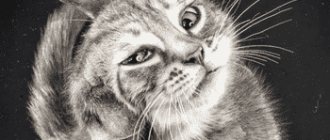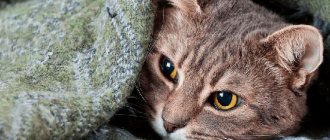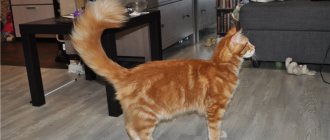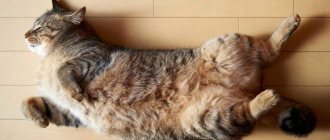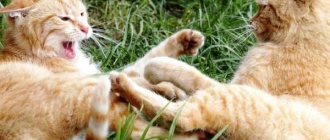Domestic cats are the ancestors of wild cats, so the activity of animals increases with the onset of dusk. Domestic cats have retained instincts that require them to constantly be in shape, because at any moment they may need to start hunting. This is associated with the periodic manifestation of activity, especially in growing kittens, at night. Such outbursts are considered normal behavior for domestic cats.
When the pet actively hints at playing together, but the owner does not give the necessary influence, the cat will begin to run around the house for what may seem to be no reason. A cat can actively play with all objects that fall under its paws. The animal is trying to attract attention.
It is worth remembering that domestic cats are unusually vulnerable and impressionable, so the owner’s attention is important for the pet. Otherwise, he will experience stress, which in the future becomes the cause of the development of dangerous diseases.
Attracts attention
Cats are social animals. They need enough human interaction. Having run around, the cat will calm down and go to rest in its favorite place. Nowadays, it is rare for people to have several pets at once, so you should devote enough time to your only furry pet. Moreover, he himself will let you know when he loses interest in communicating with the owner.
Methods of infection
The best protection against the disease is animal vaccination. Its propaganda today covers different layers of our society, but despite this, animals become infected and die. And the reason for this is the lack of self-awareness of the person who left the pet unvaccinated. It is these cats that are at risk of contracting rabies, even if they go outside once every 5 years.
It has been scientifically proven that the rabies virus can be transmitted by any warm-blooded animal, but in practice it is usually animals such as cats, dogs, rodents (from domestic animals), foxes, hedgehogs, bats and wolves (from wild ones).
An infected creature is dangerous because of its unreasonable aggression; the threshold for self-preservation of such animals is significantly lower than normal. They can not only attack another animal, but also its owner.
The incubation period of rabies in cats (i.e., the time from the moment the animal is infected until the first symptoms of the disease appear) can vary from a week to a year (so long in isolated cases). The average period of agonizing “waiting” is from two to four weeks. This time is enough to make sure that the cat does not pose a threat to others.
Conventionally, there are three main ways of transmitting this dangerous virus:
- through the bite of an infected animal;
- after eating the meat of an infected animal;
- through blood from a wound, microcrack or scratched areas on the skin.
Even a pet is not immune from the rabies virus entering its body. He may encounter a sick animal on the street (the slightest contact is enough), eat a mouse (while the owner is not looking), or the saliva of an infected person will get into a small open wound.
Overexcited
Often, as a result of active games with the owner, the cat can become overly excited, and it takes some time for him to calm down after this.
Therefore, the pet can behave hyperactively for quite a long time after the end of the game itself. If cases recur without the owner's participation, you should visit a veterinarian. Cats, like people, can suffer from nervous system disorders. Now there are many ways to bring an animal back to normal.
Why does a cat walk around the house and meow for no reason?
The reasons why cats start running around the house and meowing are varied and are not always a sign of developing health problems. Activity and constant meowing can be triggered by lack of physical activity, excess body weight, age, or the rehabilitation period after undergoing surgical manipulation.
If the cat's activity bothers the owner, it is a reason to contact a veterinary clinic for help. Thus, reduced activity can become a factor in the development of obesity. It is necessary to adjust the diet and encourage the pet to be active. Among the main reasons that lead to a cat running around the house and meowing are:
Hormonal imbalance - the onset of sexual heat in unsterilized cats and female cats provokes activity;
Disruption of the body’s functioning – pathologies of body systems that can cause increased activity and anxiety in a pet;
Change of place of residence - cats are animals with a delicate animal organization, so any stressful state can negatively affect general behavior.
Young cats, due to their young age, are very active, sociable and unusually playful, so they can run around the house at inappropriate times for the owner. In order to tame a kitten and establish its regime, you must have truly angelic patience.
Many cats are very sociable, despite the fact that they have a completely different reputation. Moreover, cats become attached to their owner, therefore, in the absence of attention from their owner, cats begin to direct attention to themselves in all sorts of ways. A cat running and meowing around the house, not receiving enough attention, is trying to encourage its owner to communicate. In addition, young cats are very energetic, although they spend most of their lives sleeping. Most of the time cats are awake, they begin to improve their hunting abilities. If a cat does not have the opportunity to run and jump during the day, it begins to splash out energy at night.
The following conditions can provoke this behavior in a cat:
- Feeling of hunger in both small kittens and adult cats. A cat may start screaming wildly when it is hungry and cannot satisfy it on its own. The stronger the pet experiences a feeling of hunger, the louder it makes itself felt, with screams and active movements. Most often, cats show anxiety with loud screams in the morning after waking up. In addition to hunger, a cat may experience thirst.
- Getting used to a new place of residence. A small kitten entering a new home may experience discomfort, so it shows its anxiety by meowing pitifully and wandering around the house.
- Demand to help. Most little kittens consider their owner to be the eldest in the pack, so they can ask for help when they cannot cope with the problems presented to them on their own.
- Danger warning. Cats love affectionate treatment, but when a threat appears, they may start screaming, meowing loudly or running away.
- An attempt to manipulate its owner. Domestic cats are real cunning, therefore, with the help of activity and loud screams, they can try to achieve what they want. A cat may beg for treats or forbidden foods, putting psychological pressure on its owner.
- Diseases. A cat can make loud mewing sounds when experiencing painful sensations. A pet may meow because it suffers from diseases of the urinary system (urolithiasis) or foreign bodies in the intestines. A cat meows invitingly and can ask its owner for help, indicating its unhealthy condition. It is necessary to promptly pay attention to your pet’s behavior, especially if there is a bowel disorder, loss of appetite, polydipsia, or a decrease or increase in temperature. It is recommended to contact a veterinary clinic for help.
In addition to the above reasons, requests for a walk can provoke such behavior in a cat. Without free access to the street, a cat may meow or scream invitingly, especially when the owner does not respond. The animal may become very frightened and experience stress due to this background. A cat can be frightened by the noise of a hair dryer or a car alarm. As soon as the pet calms down, the screaming and running around the house stops.
Boredom provokes strong screams at night in cats, especially when the house is immersed in silence. Cats are nocturnal animals, so they are most active at night. A meowing cat indicates that it is time to actively play or eat. In addition, cats also like to eat at night, so they can beg for food.
Activation at night in a cat is also provoked by the onset of sexual heat. During the period of estrus, cats begin to behave untypically, making loud sounds, notifying everyone in the area about the onset of sexual heat. Not only cats, but also males make loud noises, especially when they fight at night.
Purring and running around the house is a sign that the cat wants to talk to its owner. An animal can make sounds of different tones every day, wanting to communicate. The sounds made by the animal can be melodic or loud when the owner is talking on the phone. The most talkative cat breeds are Siamese cats, as well as Abyssinians, Orientals and Burmese.
If a cat runs around the house and meows, the reason may lie in strong anxiety before the birth process, especially if the pet is pregnant for the first time. The animal may become anxious, scream and run.
Being true predators by nature, cats can actively scream or run around the house if they sense prey. The hunting instinct, especially in cats living in a confined space, leads to the animal becoming nervous. Hunting for rats and cockroaches, flies and mice - makes the cat active, making fancy meowing sounds.
Wants to “walk”
This applies to variants of absolute norms. The cat's natural desire to continue its breed can result in overly active behavior. Females also ask for a cat with a certain frequency. There are 2 solutions here:
- regular use of hormonal medications;
- castration or sterilization.
Owner's behavior after surgery. Surgical removal of genitalia procedures are performed quickly. But recovery will take some time. During this period, the animals are too weak and need special attention from the owner.
It is unacceptable to leave pets after surgery with sources of possible dangers, in particular water.
The toilet lid should always be down. Other containers must also be closed. In addition, it is important to take care of a balanced diet and avoid the development of obesity.
What diseases provoke the appearance of convulsive seizures?
Pathology is caused by diseases of the central nervous system, severe disorders of general metabolism, and systemic intoxication of the cat’s body with synthetic substances or toxins.
Brain damage
Damage to the central nervous system leads to disruption of the transmission of electrical impulses in the neuromuscular system. As a result, a prolonged contraction of all skeletal muscles occurs, which is accompanied by the absence of unconditioned reflexes. The following pathologies can lead to disorder:
- Tick-borne encephalitis. During its life, the tick releases toxins into the blood that destroy nerve fibers. The risk of developing seizures increases if your cat experiences nosebleeds, lethargy, refusal to eat, aggression, and fever. Before convulsions, the animal loses the ability to coordinate movements, tilts its head forward due to tension in the neck muscles. Insects are removed using vegetable oil. The wound is treated with an alcohol solution. After this, it is necessary to monitor the animal’s condition for 14 days.
- Epilepsy. The animal loses consciousness, clonic-tonic convulsions appear, increased secretion of saliva and foam from the mouth, and shortness of breath are observed. The pet involuntarily defecates. Heartbeat accelerates. After an attack, the cat is in a state of shock, gets scared and does not recognize the situation. Due to excessive loss of fluid, thirst appears.
- Rabies virus. An incurable disease requiring the animal to be euthanized. Most often, seizures occur before death, when the cat stops showing aggression. In the atypical form, clonic convulsions appear. The animal moves little, vomiting and diarrhea, and increased salivation are observed.
- Severe hypoxia. Insufficient oxygen supply to the brain is accompanied by impaired transmission of nerve impulses to the muscles, blue discoloration of the mucous membranes, loss of consciousness and acute respiratory failure. The pathology can be chronic. In this case, short-term attacks are observed up to 3-4 times a month.
- Acute form of toxoplasmosis. A parasitic disease can be suspected as a result of clear discharge from the cat's nose, coughing, or fever. If microorganisms enter the liver, jaundice occurs.
- Hydrocephalus. It is observed in newborn kittens. The skull is enlarged and filled with fluid, compressing the brain. The result is developmental delay. Seizures appear at 2 months. Frequent and prolonged twitching is a sign of imminent death. In the later stages of development of hydrocele, the kitten loses vision and develops strabismus.
- Vitamin B1 deficiency. Insufficient intake of thiamine in the body leads to damage to certain areas of the brain involved in the coordination of movements. Characterized by the development of tremor and limb spasms. A characteristic sign of pathology is contraction of the muscles of the back and neck, due to which the cat throws its head up.
- Malignant neoplasms. Tumors compress the brain, leading to disruption of the central nervous system. The cat walks in circles for a long time, not paying attention to obstacles. Owners note changes in the animal's behavior.
- Head injuries. The pathology is accompanied by frequent fainting, vomiting, nystagmus, and lens dislocation. Severe swelling occurs in the damaged area. Anemia is observed and vomiting appears.
Metabolic disease
There are a number of metabolic disorders that can provoke the development of convulsions:
- Eclampsia. Characterized by a decrease in plasma calcium concentration. It appears in cats during pregnancy and lactation. The pathological process begins with twitching of the hind legs, muscle spasms in the head and neck area. Gradually, the spasms spread throughout the body, their intensity increases. The animal falls and makes uncoordinated movements. In severe cases, the pet falls into a coma or dies.
- Hypoglycemia. A sharp drop in serum glucose levels causes tonic-clonic seizures. The symptomatic picture is similar to an epileptic seizure. A seizure due to hypoglycemia occurs when a cat is given a high dose of insulin. To stabilize glucose levels, you can give your pet water with sugar. In stationary conditions, intravenous administration of glucose solution is allowed.
- Kidney failure. Pathology can be provoked by autoimmune disorders, inflammatory and infectious diseases, and severe intoxication. In rare cases, renal failure occurs after anesthesia. When the organs of the urinary system are damaged, the excretion of medicinal components, active metabolites, toxic substances and bacterial waste products slows down. As a result, intoxication occurs, during which damage to the central nervous system is observed.
- Elderly pets. In old cats, age-related changes lead to metabolic disorders, hormonal imbalance, and chronic diseases. An unbalanced diet, infectious diseases, kidney and bladder stones, and sterilization can lead to this outcome.
Poisoning in cats
Systemic intoxication can be caused by:
- poisons of indoor plants;
- medications;
- salts of heavy metals;
- household chemicals;
- fertilizers for plants;
- bacterial waste products, helminth damage.
In 80% of cases, the gastrointestinal tract is first affected. From there, toxins are absorbed into the systemic bloodstream. Next, the nerve fibers are destroyed. The pathology is accompanied by internal bleeding, aggression, dyspeptic disorders and tonic-clonic convulsions.
If the owner sees an animal swallowing a toxic substance, it should not be vomited. When seizures develop, stomach contents can block the airways.
Causes of seizures in cats
Your pet may have seizures due to:
- Epilepsy is a rare disease among cats that is difficult to diagnose;
- Inflammation of the brain - non-purulent meningoencephalitis, which is also problematic to diagnose;
- Lymph or tumors;
- Cerebral ischemic encephalopathy, in which blood flow to the cat's brain deteriorates and as a result, seizures begin;
- Infectious peritonitis is a condition in which damage occurs to the brain, abdominal cavity and kidneys. This disease is provoked by the rabies virus, leukemia, coronovirus and cryptococci;
- Toxoplasmosis, which affects the cat’s immune system and is dangerous to the human body;
- A stroke in which only the hind legs cramp. In this case, you should immediately call a veterinarian at your home;
- Hyperparathyroidism is a disease in which weakness of the pelvic limbs is observed and cramps of the hind legs occur;
- Calcium leaching from the cat's body, a similar condition can occur in cats after a recent birth. In this case, the kittens are taken away for a while and put on artificial feeding, and the cat is given drugs to replenish calcium in the body;
- Infections with ticks or helminths;
- Drug overdose or food poisoning;
- Rapid change of teeth in kittens;
- Changes in the peripheral nervous system - convulsions in a cat occur when he sleeps, which means he needs to replenish B vitamins in the body.
There are actually a lot of reasons, so you won’t be able to figure out on your own what caused the cat to have seizures. This should be done by an experienced veterinarian.
